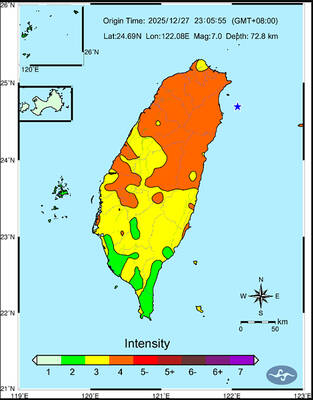Families in a village near the Iraqi border buried loved ones yesterday who they said were killed when the US military launched a rare attack in Syrian territory.
The Syrian government said four US military helicopters attacked a civilian building under construction shortly before sundown on Sunday in Sukkariyeh about 8km inside the Syrian border.
The government statement said eight people were killed, including a man and his four children and a woman. However, local officials said seven men were killed and two other people were injured, including a woman.
A journalist at the funerals in the village’s cemetery saw the bodies of seven men — none of them minors. The discrepancy could not immediately be explained.
A US military official in Washington confirmed on Sunday that special forces had conducted a raid in Syria that targeted the network of al-Qaeda-linked foreign fighters moving through Syria into Iraq.
Syria called the raid a “serious aggression,” and its Foreign Ministry summoned the charges d’affaires of the US and Iraq in protest.
Meanwhile, a suspected US missile strike killed up to 20 people in northwest Pakistan yesterday, officials said, the latest salvo in an intensifying assault on militant hide-outs near the Afghan border.
The reported missile strike occurred in South Waziristan, part of a belt of tribally governed territory considered a possible hiding place for al-Qaeda leader Osama bin Laden and No. 2 Ayman al-Zawahri.
Two intelligence officials, speaking on condition of anonymity because they were not authorized to speak to media on the record, said the targeted house in Mandata Raghzai village belonged to a lieutenant of local Taliban chief Maulvi Nazir.

A magnitude 7.0 earthquake struck off Yilan at 11:05pm yesterday, the Central Weather Administration (CWA) said. The epicenter was located at sea, about 32.3km east of Yilan County Hall, at a depth of 72.8km, CWA data showed There were no immediate reports of damage. The intensity of the quake, which gauges the actual effect of a seismic event, measured 4 in Yilan County area on Taiwan’s seven-tier intensity scale, the data showed. It measured 4 in other parts of eastern, northern and central Taiwan as well as Tainan, and 3 in Kaohsiung and Pingtung County, and 2 in Lienchiang and Penghu counties and 1

FOREIGN INTERFERENCE: Beijing would likely intensify public opinion warfare in next year’s local elections to prevent Lai from getting re-elected, the ‘Yomiuri Shimbun’ said Internal documents from a Chinese artificial intelligence (AI) company indicated that China has been using the technology to intervene in foreign elections, including propaganda targeting Taiwan’s local elections next year and presidential elections in 2028, a Japanese newspaper reported yesterday. The Institute of National Security of Vanderbilt University obtained nearly 400 pages of documents from GoLaxy, a company with ties to the Chinese government, and found evidence that it had apparently deployed sophisticated, AI-driven propaganda campaigns in Hong Kong and Taiwan to shape public opinion, the Yomiuri Shimbun reported. GoLaxy provides insights, situation analysis and public opinion-shaping technology by conducting network surveillance

Taiwan is gearing up to celebrate the New Year at events across the country, headlined by the annual countdown and Taipei 101 fireworks display at midnight. Many of the events are to be livesteamed online. See below for lineups and links: Taipei Taipei’s New Year’s Party 2026 is to begin at 7pm and run until 1am, with the theme “Sailing to the Future.” South Korean girl group KARA is headlining the concert at Taipei City Hall Plaza, with additional performances by Amber An (安心亞), Nick Chou (周湯豪), hip-hop trio Nine One One (玖壹壹), Bii (畢書盡), girl group Genblue (幻藍小熊) and more. The festivities are to

AFTERMATH: The Taipei City Government said it received 39 minor incident reports including gas leaks, water leaks and outages, and a damaged traffic signal A magnitude 7.0 earthquake struck off Taiwan’s northeastern coast late on Saturday, producing only two major aftershocks as of yesterday noon, the Central Weather Administration (CWA) said. The limited aftershocks contrast with last year’s major earthquake in Hualien County, as Saturday’s earthquake occurred at a greater depth in a subduction zone. Saturday’s earthquake struck at 11:05pm, with its hypocenter about 32.3km east of Yilan County Hall, at a depth of 72.8km. Shaking was felt in 17 administrative regions north of Tainan and in eastern Taiwan, reaching intensity level 4 on Taiwan’s seven-tier seismic scale, the CWA said. In Hualien, the